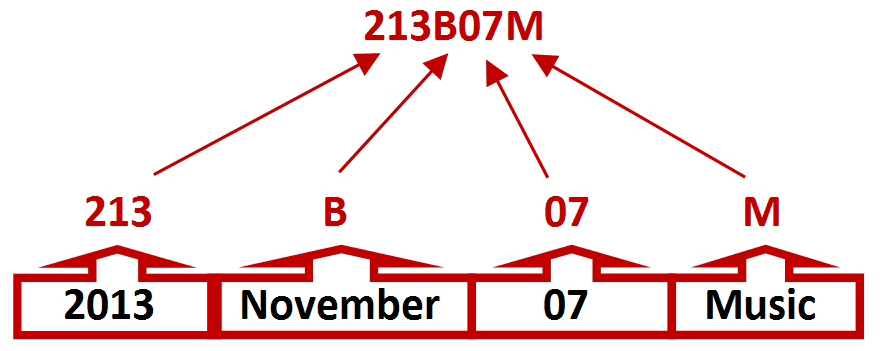WORKS CATALOGUE SYSTEM
This catalogue system is a work in progress, the aim further being to compact it even more with the purpose of creating an interrogated online database for a catalogue smart search engine. The catalogue of works [COW] is organized in several columns, each containing a different set of data:

On the left side of the works in the catalogue there is a coded catalogue number:

The code is comprised of three groups of several digits:

This allows for uniquely identifying and indexing the works both in the catalogue and in a database, as it encodes detailed information about the work it represents:
- the first group of digits contains information about the date a work was completed,
- the second group contains specific information about the work,
- the third group contains information about genre and type of appropriate performance
This was done in order to enhance the capability of sorting through the catalogue data, as needed. The first group of digits encodes:
- year (1-xx or 2-xx),
- month (1-9, A, B, C),
- day (1-3X)
- type of work (Music, Writing, etc.).
Year: All works in this catalogue are from the 20th and 21st century, so the 4-digit year index was reduced to 3 digits. 1 means the work was produced up to year 1999 and 2 signifies that the work was produced starting in year 2000. The format for year is 19xx or 20xx compacted to three digits. For example, digits 188 means that the work was produced in 1-88 or 1988, while 210 means that the work was produced in 2-10 or 2010. An ever better reduction would be to replace 19xx with A and 20xx with B making the code more compact.
Month: Since there are 12 months in the year, best practice would mean to use 0-9 for reducing the index to one digit. However, in order to make it easier to extract the correct information at a quick glance, months were numbered starting with 1, digits 1-9 representing January through September. For coding October, November and December this cataloguing system uses the alphabet letters A, B, and C.
Day: Days are coded using 2 digits in order to be represented as it is already customary. When days are unknown x symbols are used instead
Type: In order to keep the coding minimal, one digit is used to represent the “type of work” data. Music is coded M, and written works are coded W. The amount of specific material takes precedence in the case of combinations. For instance, an opera with original libretto contains both music and written material. However, the amount of musical material takes precedence and so it will be catalogued as music. If the libretto is for some reason published separately as a standalone work or as part of the production of a different composer, than the libretto will be catalogued W meaning “written work.” A musical theatre for example will be catalogued M while a translation will be catalogued W. Other encoding will be added as necessary.

The second group of digits encodes the first three letters of the title, duration in minutes, and instrumental combination.

And the encoding for a solo violin work named for example “Natalie” with a duration of 6 minutes is as follows:
NAT0600SOVI
A search for solo violin pieces through the catalogue would easily sort by the SOVI identifier placed in those particular positions of the database. In order to preserve the format, any unnecessary data is replaced with 0, which a search engine would be programmed to ignore in particular fields, as presented in the example below which is a solo work for orchestra without soloists or chorus:
SAS0344OR00
The third group of digits encodes supplementary information about the genre and fitness of each particular work. The following encoding is currently in use and is under revision:
CO Chamber Orchestra
TE Theater
BA Balade
JA Jazz
ED Educational
AC Acousmatic, etc.
AD Advertising
IN Indie
HR Hard Rock
PO Poetry
PR Prose
LY Lyrics
LI Libretto
BO Book
TR Translation
LP Live Performance
ST Soundtrack
RE Audio Recording
MM Multimedia
OP Opera
MT Musical
OR Orchestra
SO String Orchestra
SO Symphonic Orchestra
CH Chorus
